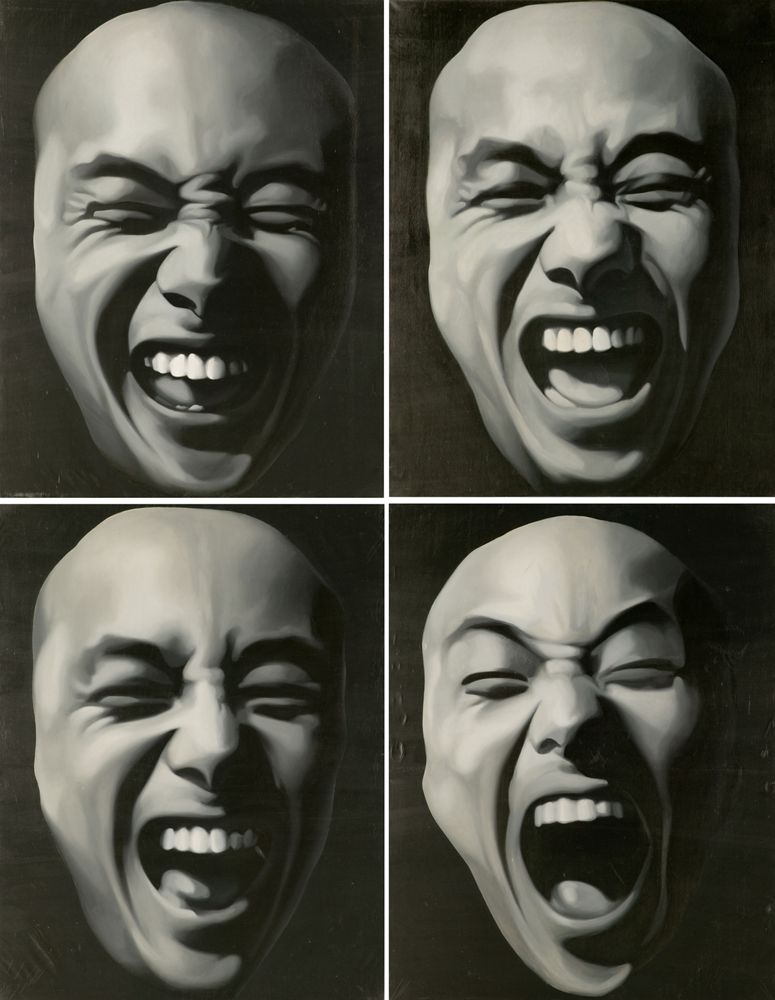Listen to

M+ Sigg Collection, Hong Kong, © Geng Jianyi. Photo: M+, Hong Kong
PRESENTER:
When you look at this piece by Geng Jianyi, how does it make you feel? Four large panels, presenting tightly cropped faces; faces that are smiling, laughing out towards us. But…is that all?
WINTON AU:
So, you see there’s some contraction, around the eyebrow areas there. So, there's this frowning expression there, and this is something not within part of the smiling facial expressions. So, frowning is actually more particular in the expression of sadness, fear and anger. That makes me wonder, actually, what is he… not only feeling, but is there something that he wants to tell you that he’s feeling? That complexity is interesting here.
PRESENTER:
That’s Winton Au, a professor of psychology. We spoke to him about how we express our emotion and respond to other people’s faces and emotions on a more primal level.
WINTON AU:
We tend to think that when we feel something, we express that in our facial expressions. So, it's our emotions, they are determining the way we express emotions, but actually this can turn the other way round. So, if we put on our different emotional expressions, facial expressions, that will affect our feelings too. What it means is that basically if you put on a happy smile, then you're more likely to feel happy; you put on a sad face, you're more likely to feel sad. So, this is what we call the facial feedback loop.
PRESENTER:
Clearly, our emotions and facial expressions have some complex and interesting correlations. Looking back at Geng Jianyi’s work with its conflicting indicators of happiness and anger, how do you feel now—and does it make you think differently about how this person was feeling?
NARRATOR:
The Second State, created in 1987 by Geng Jianyi, is a set of four vertical oil-on-canvas paintings, each 170 centimetres high and 130 centimetres wide.
This work is composed of four similar oil portraits of a man’s face. In each painting, the man shows different expressions like laughing and grinning. The paintings are all done in soft grey tones that are blended to avoid sharp lines or edges. The artist has painted these in a style called photo-realism, and, from a distance, these paintings look like black-and-white photos.
All paintings feature the same man from a similar perspective, showing only his face. The artist does not show his ears, and this gives a mask-like quality to the image. His face covers the entire canvas leaving a small amount of space around the edges to reveal a black background. In each painting, his forehead takes up about one-third of his face. It is smooth and without wrinkles. Not seeing the man’s hair, it is not clear if he is bald or if the hair is not visible. The man’s eyebrows are raised and scrunch together causing the top of his nose to wrinkle up. The man’s nose has a fleshy tip and is at the centre of each of the paintings. With a colour contrast effect, the nose seems to protrude from the painting. Many wrinkles are clearly depicted around the man’s eyes.
In each of the four paintings, the man has a different grin with his mouth opened wide showing a portion of his tongue. His upper teeth are neat and clearly depicted in white. These white teeth create a strong contrast with the grey scale tone of his face and the black background. The shape of the man’s mouth also varies in each painting. In one of the paintings, his mouth looks like the shape of a giant kidney bean and only a line of lower teeth can be vaguely seen. The man opens his mouth wider in two other images, looking like an inverted triangle with round corners with no lower teeth in view. In the image where the man has the broadest grin, his mouth is shaped like a huge oval so large that it could fit the fist of an adult man.